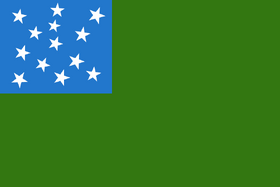
| |
| Official language | English |
| Capital | Montpelier |
| President of the Executive Council | |
| Independence | 1777 (declared) 1798 (recognized by Britain 1801 (recognized by New York and New Hampshire) |
| Currency | Vermont Dollar |
On January 8, 1777, the Republic of New Connecticut (soon renamed Vermont) was declared, renouncing New York's authority. For much of the Revolution, Vermont remained neutral, though many of their soldiers fought alongside the rebels.
During and after the end of the War, Vermont sought membership in the newly-formed United States of America, but the Continental Congress put off the decision to avoid antagonizing New York and New Hampshire.
After the end of the War, Vermont, fearing New York or New Hampshire might attempt to enforce their sovereignty, negotiated with both the United States Congress and the British seeking clarification of its status.
In 1798, the Vermont Treaty of Union was signed with Britain. Under the terms of the Treaty, Vermont agreed to recognize the authority of King George III, through the appointment of a Governor (later renamed Viceroy), who worked with the elected Executive Council and an elected Lieutenant Governor. Legislative authority for the Union, however, would lie with the House of Representatives of Vermont. The House would have the right to veto acts of the British Parliament pertaining to Vermont, but the British Parliament in turn had veto power over the House's acts.
In 1843, a new Constitution was adopted. Under this constitution, the title of Lieutenant Governor was changed to President of the Executive Council. The Viceroy also became an elected position.
The monarchy was abolished and political ties with Britain severed on January 1, 1901.
